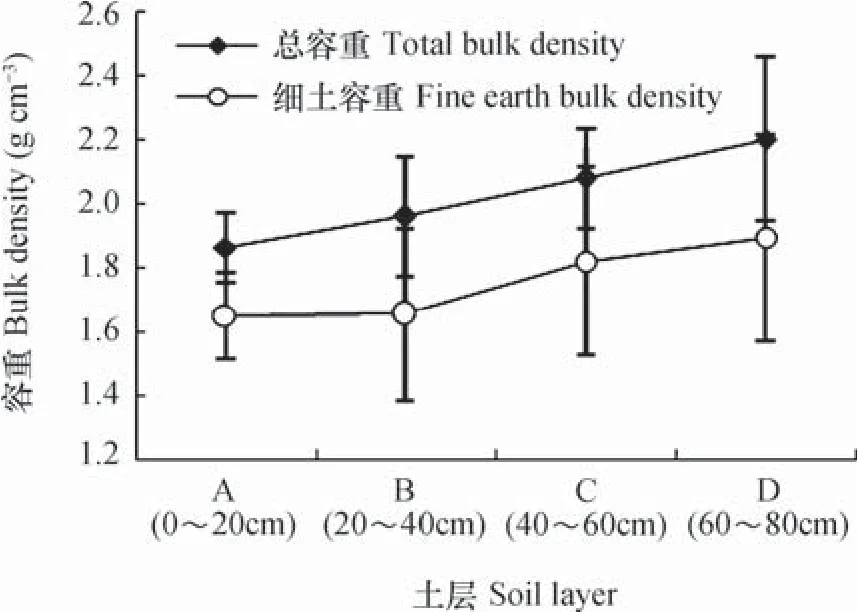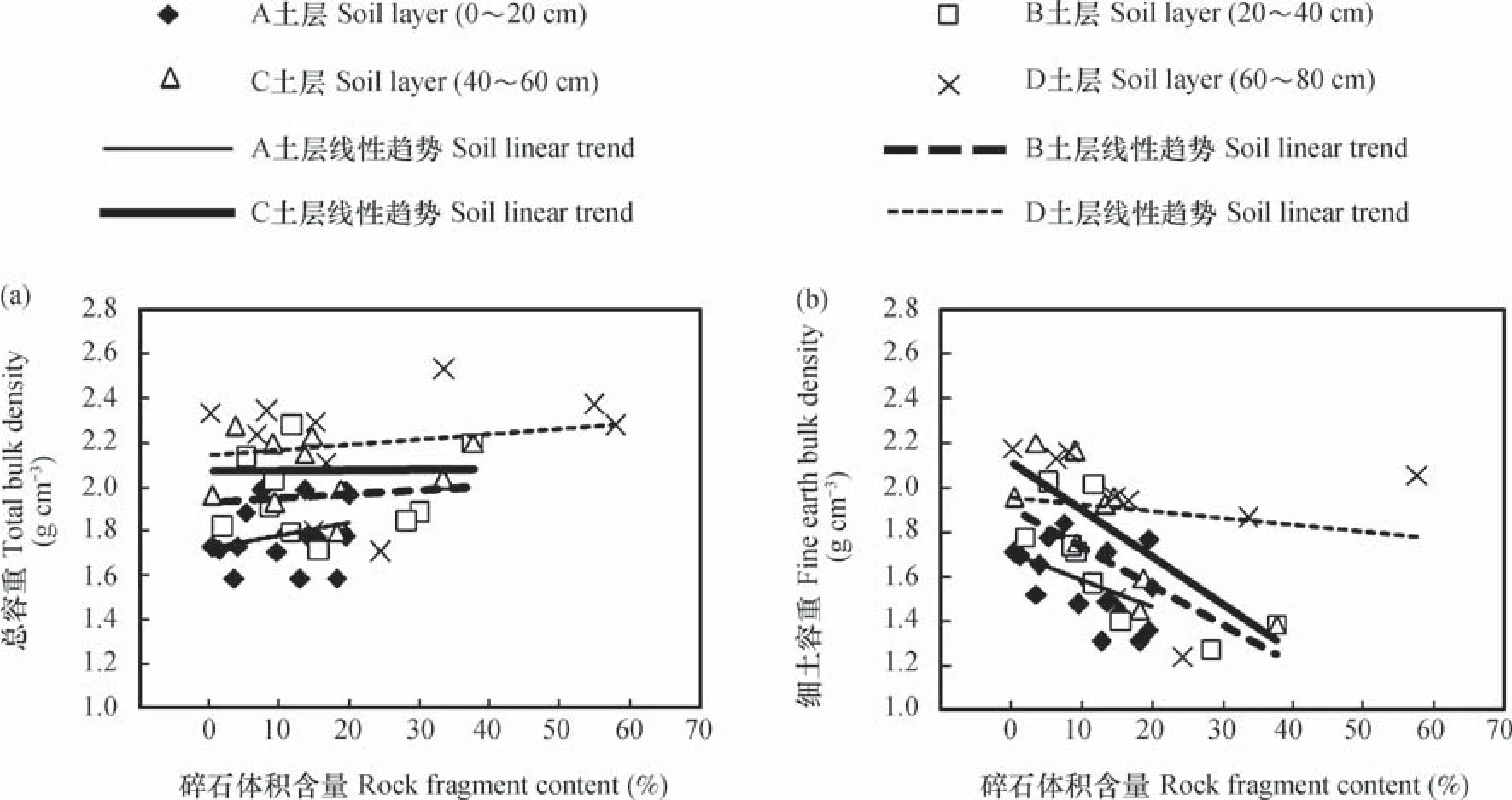三峡库区碎石含量对紫色土容重和孔隙特征的影响*
2017-04-19王小燕蔡崇法李鸿谢德体
王小燕蔡崇法李 鸿谢德体
(1 西南大学资源环境学院三峡库区生态环境教育部重点实验室,重庆 400715)
(2 华中农业大学资源与环境学院水土保持研究中心,武汉 430070)
三峡库区碎石含量对紫色土容重和孔隙特征的影响*
王小燕1蔡崇法2†李 鸿1谢德体1
(1 西南大学资源环境学院三峡库区生态环境教育部重点实验室,重庆 400715)
(2 华中农业大学资源与环境学院水土保持研究中心,武汉 430070)
土壤容重和孔隙分布特征是土壤重要的基本物理性质,但有关含碎石土壤的物理性质以及碎石含量对土壤结构影响的研究尚不多见。三峡库区紫色土中存在大量的碎石,为了深刻了解和评价土壤中碎石对容重与大孔隙形成的可能作用,通过野外调查、典型土样采集和室内分析实验,探讨了三峡库区典型土地利用类型下土壤中的碎石体积含量以及不同粒径碎石的基本物理性质及其对土壤容重和孔隙特征的影响。结果表明:土壤中碎石的孔隙度和饱和含水率随着碎石粒径的减小而增大,小碎石本身具有一定的持水、供水性能;碎石含量对土壤的总容重、细土容重有显著影响,随着碎石含量的增加,土壤的总容重逐渐增加,而细土容重与碎石含量呈线性负相关关系,土壤中碎石的存在有利于改善土壤的结构;土壤孔隙分布特征与碎石含量密切相关,随着碎石含量的提高,土壤总孔隙度和毛管孔隙度呈减少趋势,而非毛管孔隙度即大孔隙呈增加趋势,碎石的存在有利于改善土壤的透水性能。本研究为山区农用地灌溉与水分管理提供了科学依据。
紫色土;碎石;容重;孔隙;三峡库区
受成土过程和人为活动的影响,碎石(>2 mm)在土壤中有着广泛的分布。碎石的分布对土壤的化学风化速率[1]、养分供给[2]、水文响应[3-4]以及表土侵蚀速率[5]等均有重要影响。土壤中碎石通过各种方式影响土壤水蚀过程,Poesen等[6]将这些影响方式分为直接影响和间接影响。碎石对土壤侵蚀的直接影响包括保护表土免受雨滴击溅和径流冲刷的分散,或阻截溅散的泥沙;碎石间接影响土壤侵蚀的方式多种多样,主要包括以下几个方面:(1)改变会影响土壤侵蚀过程中土壤物理性质(如容重、孔隙度等),(2)影响表层土壤的物理退化过程(如表土结皮等),(3)影响与径流产生及流量等有关的水文过程(如入渗和渗透),(4)径流的水力特性。同时是否考虑土壤中碎石,土壤中的有效含水量、土壤水渗漏到地下水中的量以及植物能吸收的有效水含量存在很大的差异[7-8],在研究含碎石土壤的各种性质时不能忽略碎石的存在。以往研究很少有对碎石与容重和土壤孔隙之间关系做出直接的解释,而且以往的土壤大孔隙研究也多是在土壤质地相对均一的条件下进行的,对以物理风化为主、土壤发育程度不深、碎石含量很高的坡地紫色土中碎石在土壤大孔隙形成中作用的研究还相当缺乏。本研究旨在了解三峡库区紫色土中的碎石对土壤容重和孔隙特征的影响及其可能的作用机制,为建立准确预报、模拟径流和土壤侵蚀的时空变化规律的模型提供土壤空间分布的基本参数,也为流域治理和土壤保护提供理论依据。
1 材料与方法
1.1 研究区概况
本文的研究对象是三峡库区的紫色土,试验区位于三峡库区秭归县王家桥小流域。王家桥小流域位于31°05′~31°15′N,110°40′~110°47′E,属于长江二级支流,距长江约9 km。流域总面积16.7 km2,自北偏东向南偏西呈窄条状,南北长7 km,东西宽3.5 km。三峡库区年平均气温为17~19℃,年降水量1 000~1 250 mm,降雨集中在4—10月,特别是5—9月常有暴雨出现。流域海拔为184~1 180 m。流域坡度较陡,25°~35°的坡地占35%,大于35°的坡地占50%,以柑橘种植为主,属典型的山区小流域。该流域出露地层为侏罗系蓬莱镇组紫灰色石英砂岩、棕紫色灰质砂岩与棕紫色泥岩互层,含透镜状砾岩及硅化木,土壤为中性和石灰性紫色土[9]。紫色母岩一经出露地表,在光、热、水等自然因素的作用下,迅速发生物理风化。据观测,一般可发现需经历以下几个物理风化特征阶段:岩层—崩解—碎屑化—成壤(土)—化泥[10]。紫色土在发生分类上称初育土,在系统分类上分属新成土和雏形土。在土壤性质上是一种特殊的土壤类型,快速风化是其中的一大特殊性质之一。蓬莱镇组的成土速率较大,可达12 000 t km-2a-1[11]。该区紫色土表现出土层薄、碎石含量高等特点,具有坡地紫色土的典型特点。
1.2 土壤与碎石基本物理性质的测定
关于样点的布设与样品采集以及碎石体积含量测定详见笔者已发表论文《三峡库区紫色土碎石分布特征》[12]。
在分析含碎石土壤特性时,需要区别两个容重概念:总容重和细土容重。总容重和细土容重的测定:将采取土样(30 cm×30 cm×20 cm)(V总)烘干称重获得含碎石土壤总质量m总;将通过水洗法获得的碎石采用排水法获得碎石体积V碎石;将碎石烘干称重获得碎石质量m碎石,最后通过式(1)和式(2)计算含碎石土壤的总容重和细土容重:
总容重BDt=土壤总质量m总/土壤总体积V总(1)
细土容量δf=(土壤总质量m总-碎石质量m碎石)/(土壤总体积V总=碎石体积V碎石) (2)
碎石基本物理性质的测定:随机选取不同粒径级别的碎石各10颗,放入温度设定为105°的烘箱内,24 h后取出称重获得碎石烘干质量m0;常温下将碎石浸泡于纯净水中24 h,使碎石充分吸水称重,获得碎石饱和含水质量m1;在碎石表面涂抹一薄层防水的石蜡,再通过排水法获得碎石的体积v,最后通过下列各式计算碎石的密度、孔隙度和饱和含水率:
碎石密度BDrf=碎石烘干质量m0/碎石体积V碎石(3)
碎石孔隙度Prf=(碎石饱和含水质量m1-碎石烘干质量m0)/纯水密度ρ/碎石体积V碎石(4)
碎石饱和含水率SWrf=(碎石饱和含水质量m1-碎石烘干质量m0)/碎石烘干质量m0(5)
2 结果与讨论
2.1 碎石的基本物理性质
紫色土中的碎石一般为紫色泥岩、页岩或砂岩、泥砂岩风化的产物,形状以不规则块状为主,少量为长棱形、片状。紫色母岩的矿物组成一般较为复杂,在干湿交替、冷热循环条件下,不同的导热率和胀缩性加剧了紫色母岩的物理风化速度。岩石首先从大块状龟裂风化为大于2 mm的碎屑(碎石)成为疏松多孔的土壤母质,具备了一定的水贮存运移能力。紫色岩碎石继承了紫色母岩的性质,风化程度的差异,导致其密度、孔隙度和饱和含水率的差异。图1显示了小、中、大三种粒径碎石的密度、孔隙度和饱和含水率,不同粒径碎石的密度、孔隙度和饱和含水率有显著差异。不同粒径碎石的风化程度不同,随着碎石粒径的增大,碎石的风化程度降低,其密度逐渐增大,依次为1.9、2.2、2.3 g cm-3(图1a),而碎石的孔隙度和饱和含水率逐渐减少,小碎石、中碎石和大碎石的孔隙度依次为0.16、0.10、0.06 cm3cm-3(图1b),三种粒径碎石的饱和含水率依次为8.0%、4.5%、3.2%(图1c),这与李燕等[13]的研究结果相一致。在分析土壤水分性质与预测土壤有效水分含量时,碎石所持有的水分常常被忽略不计,但在含碎石土壤中,特别是当碎石含量较高时,这部分水分具有重要的作用。在石质山区,植物吸收的水分以及蒸腾所需水分大部分来自岩石裂缝渗水。干旱条件下,植物所吸收的水分大部分来自深度风化的岩石[14]。有研究进一步指出,与表层土壤相比,底层的风化岩石能为作物生长提供更多的有效水分[15-16]。Hubbert等[17]的研究也表明,在含碎石土壤中,土壤中的碎石为植物生长提供了70%的水分。
2.2 含碎石土壤的容重
分析含碎石土壤A(0~20cm)、B(20~40cm)、C(40~60cm)、D(60~80cm)各土层的容重,结果显示,随着土层加深,土壤总容重和细土容重提高(图2)。大量研究结果表明,随着土层深度的增加,由于土壤愈加紧实,土壤有机质含量降低,团聚体减少,且植物根系量显著降低等原因,土壤容重逐渐加大[18-19]。

图2 不同土层含碎石土壤的总容重和细土容重Fig. 2 Total bulk density and fine earth bulk density of soils containing rock fragments for different soil layers
从图3可以看出,在各土层,随着碎石含量的增加,含碎石土壤的总容重逐渐增加(图3a),而含碎石土壤的细土容重逐渐减少(图3b)。碎石与细土容重呈负相关关系可归因于以下几个方面:(1)当碎石含量较高时,可能会出现细土物质未完全充填碎石之间空隙的情况,从而降低细土容重;(2)在两种级别粒径颗粒的混合体中,小部分大颗粒体的出现均能减少细颗粒组成部分的容重,因为小颗粒体与大颗粒体之间不可能像它们自身那样紧密结合[20];(3)在干湿交替或冻融与解冻交互的过程中,细土和碎石反应方式不同,这也可能引起碎石和细土之间形成孔隙[21];(4)土壤中碎石的存在改变了细土部分的性质,随着碎石含量的增加,腐烂的有机质、肥料投入和雨水等集中分布在逐渐减少的细土中[22]。而单位细土的投入物质增加将会影响其他的土壤性质,如土壤结构等。特别是细土部分有机质含量的增加(与碎石含量增加相对应)会导致细土容重的降低,因为有机质的平均密度较低,大约为224 kg m-3[23]。除了这个影响,有机质含量的增加还常常会使细土部分形成一个更好(如更高的孔隙度)更稳定的结构。图3说明了,即便是在土壤总容重较高的条件下,细土容重也不会特别高,这对植物的生长具有重要意义:如果植物生长与细土部分的物理性质有关,那么砾质土/石质土较高的总容重并不一定意味着恶劣的根系生长环境[24]。大量研究表明,无论是从经验上还是理论上细土容重均随着碎石含量的增加而降低[20,25-26]。Torri等[27]利用Stewart等[20]与Alberto[25]发表的有关森林与农业土壤的调查数据,建立了碎石质量含量与细土容重的函数关系

式中,δf为含碎石土壤的细土容重;δ0f为不含碎石的土壤容重;Mr为土壤中的碎石质量含量。式中关键参数δ0f可通过Rowls[23]提出的土壤转换函数,根据土壤的质地及有机质含量推算获得。碎石的质量含量和体积含量可以通过下列公式进行换算[22]

图3 不同土层碎石含量与总容重(a)和细土容重(b)的关系Fig. 3 Relationships of rock fragment content with total bulk density(a)and fine earth bulk density(b)in different soil layers

式中,Vr为土壤碎石体积含量,BDt为土壤总容重,BDrf为碎石密度。
2.3 含碎石土壤孔隙分布特征
图4显示了A、B、C、D各土层的孔隙分布特征。从该图可以看出,各土层的总孔隙、非毛管孔隙度、毛管孔隙度随土层深度增加而降低。这与大量已发表的研究结果相一致,土层越深,土壤体积质量越大,孔隙度降低[28-29]。

图4 不同土层含碎石土壤的总空隙度、非毛管孔隙度和毛管孔隙度Fig. 4 Total porosity,non-capillary porosity and capillary porosity for different soil layers
下面将根据不同土层分析碎石含量与土壤孔隙分布特征的关系。图5显示了碎石体积含量与总孔隙度、非毛管孔隙度和毛管孔隙度的关系,从该图可以看出,随着碎石体积含量的提高,土壤总孔隙度和毛管孔隙度呈减少趋势(图5a、图5c),而非毛管孔隙度呈增加趋势(图5b)。时忠杰等[30]在黄土区的研究也指出,碎石体积含量增加导致土壤大孔隙的平均半径和体积增大,特别是导致半径大于1.4 mm的大孔隙密度的增大。目前,有不少学者研究了土壤中碎石存在对水分入渗和渗透过程的影响,有研究结果指出土壤中碎石的存在减少了水分入渗[31-33]。Zhou等[34]的研究还得出碎石对土壤水分运动的影响存在一个阈值,当碎石含量小于40%时,入渗速率和饱和导水率随着碎石含量的增加而降低,当碎石含量超过40%时,则随碎石含量的增加而增加。王慧芳和邵明安[35]采用简单相关分析研究碎石粒径对入渗过程的影响,得出粒径2~3 mm碎石与入渗过程呈显著负相关关系,而>25 mm碎石有利于入渗。这可归因于土壤中碎石存在对土壤总孔隙度和非毛管孔隙度的不同影响。随着碎石含量的增加,土壤总孔隙度减少,这表明了土壤中碎石的存在将减少水分的过水断面;同时,非毛管孔隙度随着碎石体积含量的增加而增加,而非毛管孔隙有利于水分运动,还会促进优先流的形成,从而提高土壤的入渗速率和渗透速率,土壤中碎石的存在是促进入渗还是降低入渗最终取决于这两种相反影响的交互作用。

图5 不同土层碎石含量与总孔隙度(a)、非毛管孔隙度(b)和毛管孔隙度(c)的关系Fig. 5 Relationships of rock fragment content with total porosity(a),non-capillary porosity(b)and capillary porosity(c)in different soil layers
3 结 论
土壤中碎石的性质及其对土壤性质的影响,是碎石对水文过程和侵蚀过程产生作用的基础。通过对三峡库区典型山地紫色土含碎石原状土的基本物理性质进行调查研究,得出了以下结论:碎石的粒径越小,其风化程度越高,碎石孔隙度和饱和含水率随着粒径的减小而增大。碎石和细土两种不同数量级粒径颗粒的混合,改变了土壤的结构,碎石含量对土壤的总容重、细土容重有显著影响。随着碎石含量的增加,土壤的总容重逐渐增加,而细土容重与碎石含量呈线性负相关关系。土壤孔隙分布与碎石含量有关。随着碎石含量的提高,土壤总孔隙度和毛管孔隙度呈减少趋势,而非毛管孔隙度呈增加趋势。
[1]Yoo K,Mudd S M. Discrepancy between mineral residence time and soil age:Implications for the interpretation of chemical weathering rates. Geology,2008,36(1):35—38
[2]Vitousek P,Chadwick O,Matson P,et al. Erosion and the rejuvenation of weathering-derived nutrient supply in an old tropical landscape. Ecosystems,2003,6 (8):762—772
[3]Wang X Y,Li Z X,Cai C F,et al. Hydrological response of sloping farmlands with different rock fragment covers in the purple soil area of China. Journal of Hydrologic Engineering,2013,18(4):446—456
[4]王小燕,李朝霞,蔡崇法. 砾石覆盖紫色土坡耕地水文过程. 水科学进展,2012,23(1):38—45
Wang X Y,Li Z X,Cai C F. Hydrological processes on sloped farmland in purple soil regions with rock fragmentcover(In Chinese). Advances in Water Science,2012,23(1):38—45
[5]Wang X Y,Li Z X,Cai C F,et al. Effects of rock fragment cover on hydrological response and soil loss from regosols in a semi-humid environment in Southwest China. Geomorphology,2012,151/152:234—242
[6]Poesen J W,Torri D,Bunte K. Effects of rock fragments on soil erosion by water at different spatial scales:A review. Catena,1994,23(1/2):141—166
[7]Cousin I,Nicoullaud B,Coutadeur C. Influence of rock fragments on the water retention and water percolation in a calcareous soil. Catena,2003,53(2):97—114
[8]马东豪,邵明安. 含碎石土壤的含水量测定误差分析.土壤学报,2008,45(2):201—206
Ma D H,Shao M A. Determination error of water content in stony soil(In Chinese). Acta Pedologica Sinica,2008,45(2):201—206
[9]丁树文,蔡崇法,黄丽,等. 三峡库区秭归盆地岩性构造对坡地紫色土某些特性影响. 华中农业大学学报,2000,19(2):129—133
Ding S W,Cai C F,Huang L,et al. Influence of rock feather and structure on some properties of purple soil of slope land in Zigui Basin(In Chinese). Journal of Huazhong Agricultural University,2000,19(2):129—133
[10]何毓蓉,等. 中国紫色土:下篇. 北京:科学出版社,2003
He Y R,et al. Purple soils in China(Ⅱ)(In Chinese). Beijing:Science Press,2003
[11]李兰,周忠浩,杜树汉,等. 紫色土成土速率的估算与田间测定. 土壤学报,2010,47(3):393—400
Li L,Zhou Z H,Du S H,et al. Model-based estimation and field measurement of purple soil formation rate(In Chinese). Acta Pedologica Sinica,2010,47(3):393—400
[12]王小燕,王天巍,蔡崇法,等. 三峡库区紫色土的碎石分布特征. 土壤学报,2015,52(2):293—302
Wang X Y,Wang T W,Cai C F,et al. Spatial distribution of rock fragments in purple soil in Three Gorges Reservoir Area(In Chinese). Acta Pedologica Sinica,2015,52(2):293—302
[13]李燕,魏朝富,刘吉振,等. 丘陵紫色土砾石的性质及其空间分布. 西南农业学报,2008,21(5):1320—1325
Li Y,Wei C F,Liu J Z,et al. Characteristics and spatial distribution of rock fragments in hilly purple soils of Sichuan Basin(In Chinese). Southwest China Journal of Agricultural Sciences,2008,21(5):1320—1325
[14]Arkley R J. Soil moisture use by mixed conifer forest in a summer-dry climate. Soil Science Society of America Journal,1981,45(2):423—427
[15]Jones D P,Graham R C. Water-holding characteristics of weathered granitic rock in chaparral and forest ecosystems. Soil Science Society of America Journal,1993,57(1):256—261
[16]Zwieniecki M A,Newton M. Water-holding characteristics of metasedimentary rock in selected forest ecosystems in southwestern oregon. Soil Science Society of America Journal,1996,60(5):1578—1582
[17]Hubbert K R,Graham R C,Anderson M A. Soil and weathered bedrock:Components of a jeffrey pine plantation substrate. Soil Science Society of America Journal,2001,65(4):1255—1262
[18]韩光中,王德彩,谢贤健. 中国主要土壤类型的土壤容重传递函数研究. 土壤学报,2016,53(1):93—102
Han G Z,Wang D C,Xie X J. Pedotransfer functions for prediction of soil bulk density for major types of soils in China(In Chinese). Acta Pedologica Sinica,2016,53(1):93—102
[19]刘窑军,王天巍,蔡崇法,等. 植被恢复对三峡库区土质道路边坡抗剪强度的影响. 土壤学报,2013,50 (2):396—404
Liu Y J,Wang T W,CaiC F,et al. Effect of vegetation restoration on soil shear strength of road side slopes of unpaved roads in the Three-Gorges Reservoir Area(In Chinese). Acta Pedologica Sinica,2013,50(2):396—404
[20]Stewart V I,Adams W A,Abdulla H H. Quantitative pedological studies on soils derived from silurian mudstones ii. The relationship between stone content and the apparent density of the fine earth. European Journal of Soil Science,1970,21(2):248—255
[21]Gargiulo L,Mele G,Terribile F. The role of rock fragments in crack and soil structure development:A laboratory experiment with a vertisol. European Journal of Soil Science,2015,66(4):757—766
[22]Childs S W,FlintAL. Physical properties of forest soils containing rock fragments//Gessel S P,et al. Sustained productivity of forests soils. Faculty of Forestry,University of British Columbia,Vancouver,BC,Canada,1990:95—121
[23]Rawls W J. Estimating soil bulk-density from particlesize analysis and organic-matter content. Soil Science,1983,135(2):123—125
[24]Kosmas C,Moustakas N,Danalatos N G,et al. The effect of rock fragments on wheat biomass production under highly variable moisture conditions in mediterranean environments. Catena,1994,23 (1/2):191—198
[25]Alberto F. Considerations sur la pierrosite des sols bruns a crouite calcaire du bassin de l’ebre. Bulletin des Recherches Agronomiques de Gembloux,1971,6:180—185
[26]Flint A L,Childs S. Physical properties of rock fragments and their effect on available water in skeletal soils//Nichols J D ,Brown P L,Grant W J.Erosion and productivity of soils containing rock fragments. Simplified Spelling Society of America Special Publication,1984:91—103
[27]Torri D,Poesen J,Monaci F,et al. Rock fragment content and fine soil bulk density. Catena,1994,23 (1/2):65—71
[28]付同刚,陈洪松,王克林.喀斯特小流域土壤饱和导水率垂直分布特征. 土壤学报,2015,52(3):538—546
Fu T G,Chen H S,Wang K L. Vertical distribution of soil saturated hydraulic conductivity in a small karst catchment(In Chinese). Acta Pedologica Sinica,2015,52(3):538—546
[29]李宗超,胡霞. 小叶锦鸡儿灌丛化对退化沙质草地土壤孔隙特征的影响. 土壤学报,2015,52(1):242—248
Li Z C,Hu X. Effects of shrub(Caraganamicrophylla Lam)encroachment on soil porosity of degraded sandy grassland(In Chinese).Acta Pedologica Sinica,2015,52(1):242—248
[30]时忠杰,王彦辉,熊伟,等. 六盘山典型植被类型土壤中石砾对大孔隙形成的影响. 山地学报,2007,25 (5):541—547
Shi Z J,Wang Y H,Xiong W,et al. Effect of rock fragments on the formation of soil macro porosity of typical vegetation in Liupan Mountains of Westnorth,China(In Chinese). Journal of Mountain Science,2007,25(5):541—547
[31]Ma D H,Shao M A. Simulating infiltration into stony soils with a dual-porosity model. European Journal of Soil Science,2008,59(5):950—959
[32]李燕,刘吉振,魏朝富,等. 砾石对土壤水分入渗(扩散)的影响研究. 土壤学报,2011,48(2):435—439
Li Y,Liu J Z,Wei C F,et al. Effect of rock fragment content on water infiltration(diffusion)in purple soils (In Chinese). Acta Pedologica Sinica,2011,48 (2):435—439
[33]周蓓蓓,邵明安. 不同碎石含量及直径对土壤水分入渗过程的影响. 土壤学报,2007,44(5):801—807
Zhou B B,Shao M A. Effect of content and size of rock detritus on infiltration(In Chinese). Acta Pedologica Sinica,2007,44(5):801—807
[34]Zhou B B,Shao M A,Shao H B. Effects of rock fragments on water movement and solute transport in a Loess Plateau soil. Comptes Rendus Geoscience,2009,341(6):462—472
[35]王慧芳,邵明安. 含碎石土壤水分入渗试验研究. 水科学进展,2006,17(5):604—609
Wang H F,Shao M A. Experimental study on water infiltration of soils containing rock fragments(In Chinese). Advances in Water Science,2006,17 (5):604—609
Infl uence of Rock Fragments on Bulk Density and Pore Characteristics of Purple Soil in Three-Gorge Reservoir Area
WANG Xiaoyan1CAI Chongfa2†LI Hong1XIE Deti1
(1 Key Laboratory of Eco-environments in Three Gorges Reservoir Region,Ministry of Education,College of Resources and Environment,Southwest University,Chongqing 400715,China)
(2 Soil and Water Conservation Center,College of Resources and Environment,Huazhong Agricultural University,Wuhan 430070,China)
【Objective】Bulk density and pore distribution characteristics are two fundamental soil properties. However,not much has been reported about physical properties of soils containing rock fragments and influences of rock fragments in soil on bulk density and formation of non-capillary porosity of thesoil. Purple soil is the major type of soil in the Three-Gorge Reservoir Region and the high content of rock fragments is one of the important characteristics of the purple soil. The existence of plentiful rock fragments in the soil will sure affect the formation of bulk density and porosity characteristics. The purpose of this study is to understand how rock fragments affect bulk density and porosity characteristics and its possible mechanism in the purple soil of the region. It is expected that the findings in this study may help collect some basic parameters of soil spatial distribution for building models to be used to predict spatio-temporal variation of surface runoff and soil erosion,while providing some scientific bases for irrigation and water management of agricultural land in mountainous areas. 【Method】In order to explore in depth and evaluate potential effects of rock fragments on bulk density and porosity characteristics,soil samples typical of the soil were collected during field surveys for in-lab analysis of contents and fractions of rock fragments in particle size,soil physical properties,bulk density and porosity. 【Result】(1)Rock fragments varied sharply in density,porosity,saturated water content,and weathering degree. The larger in size,the lower in weathering degree,the higher in density,and the lower in porosity and saturated water content. The three fractions of rock fragments,small,medium and large,were 1.9,2.2 and 2.3 g cm-3in density,0.16,0.10 and 0.06 cm3cm-3in porosity and 8.0%,4.5% and 3.2% in saturated water content(mass moisture content),respectively.(2)Content of rock fragments was closely related to total bulk density and bulk density of fine earth. With increasing rock fragment content,total bulk density increased while bulk density of fine earth decreased,showing a linear negative relationship.(3)Soil pore distribution was closely related to content of rock fragments. With increasing content of rock fragments,total porosity and capillary porosity of the soil decreased while non-capillary porosity,i.e. macrospore,increased.【Conclusion】The sum up,rock fragments,especially those small in size,have certain water holding and supplying capacities. In farmlands under water stress,rock fragments can also release some water available for plant growth. The existence of rock fragments in the soil helps improve soil structure and soil water permeability.
Purple soil;Rock fragment;Bulk density;Porosity;Three-Gorge Reservoir Area
S152.5
A
10.11766/trxb201601050569
(责任编辑:檀满枝)
* 国家自然科学基金项目(41401298)、中央高校基本科研业务费专项(XDJK2013C152)和高等学校博士学科点专项科研基金新教师类课题(20130182120015)共同资助Supported by the National Natural Science Foundation of China(No. 41401298),Fundamental Research Funds for the Central Universities(No.XDJK2013C152)and Research Fund for the Doctoral Program of Higher Education of China(No. 20130182120015)
† 通讯作者 Corresponding author,E-mail:cfcai@mail.hzau.edu.cn
王小燕(1983—),女,四川岳池人,博士,讲师,主要从事水文土壤学、土壤侵蚀与水土保持方面研究。E-mail:wxy8388@gmail.com
2016-01-05;
2016-10-17;优先数字出版日期(www.cnki.net):2016-12-29
